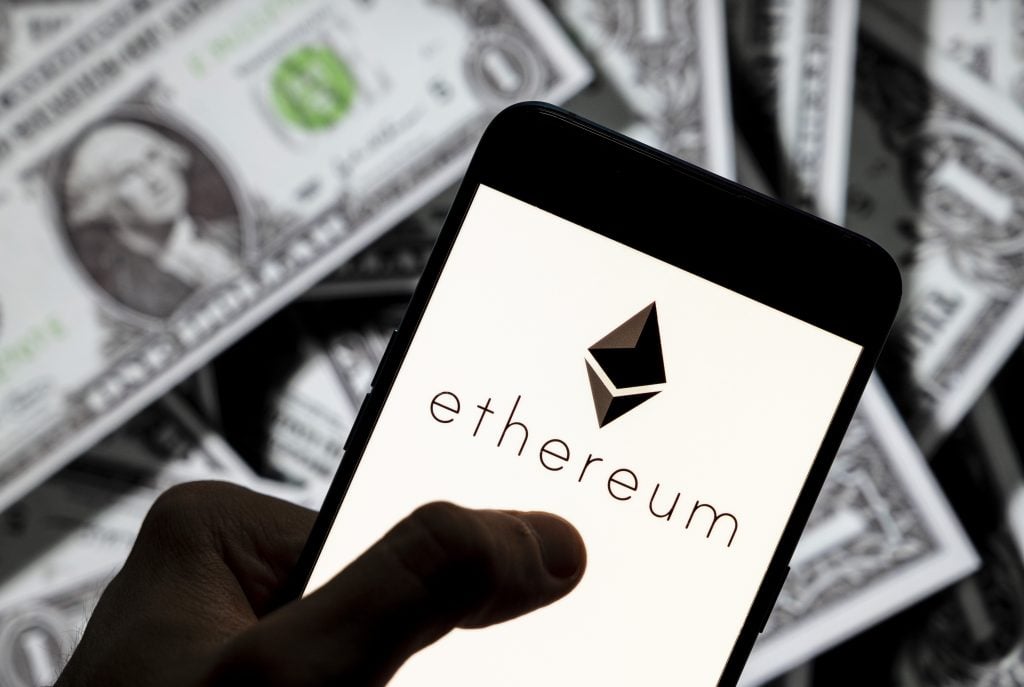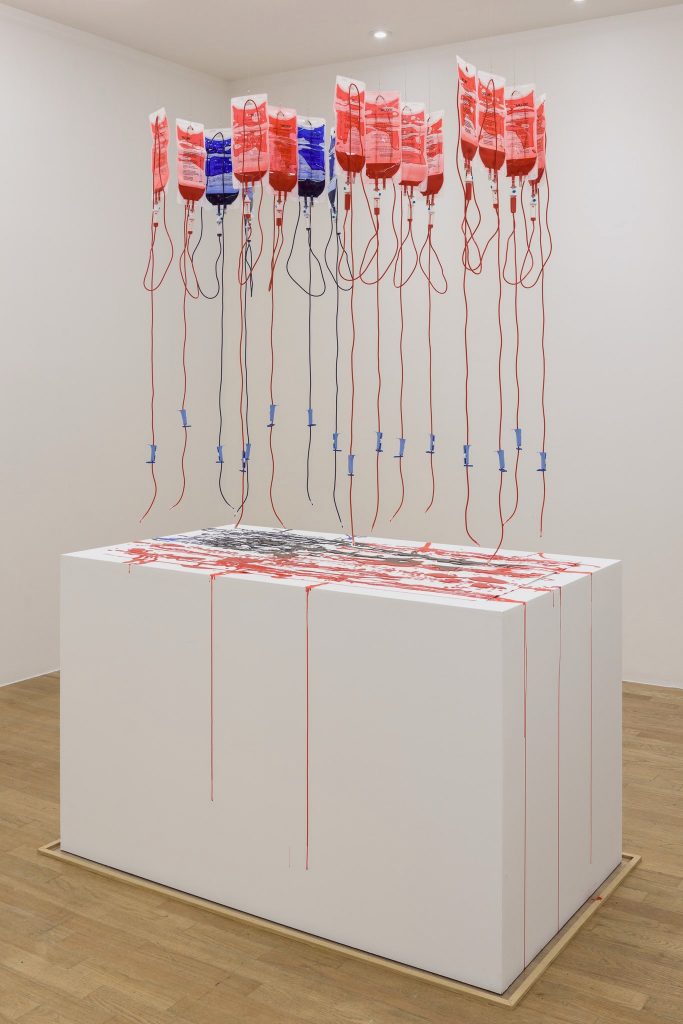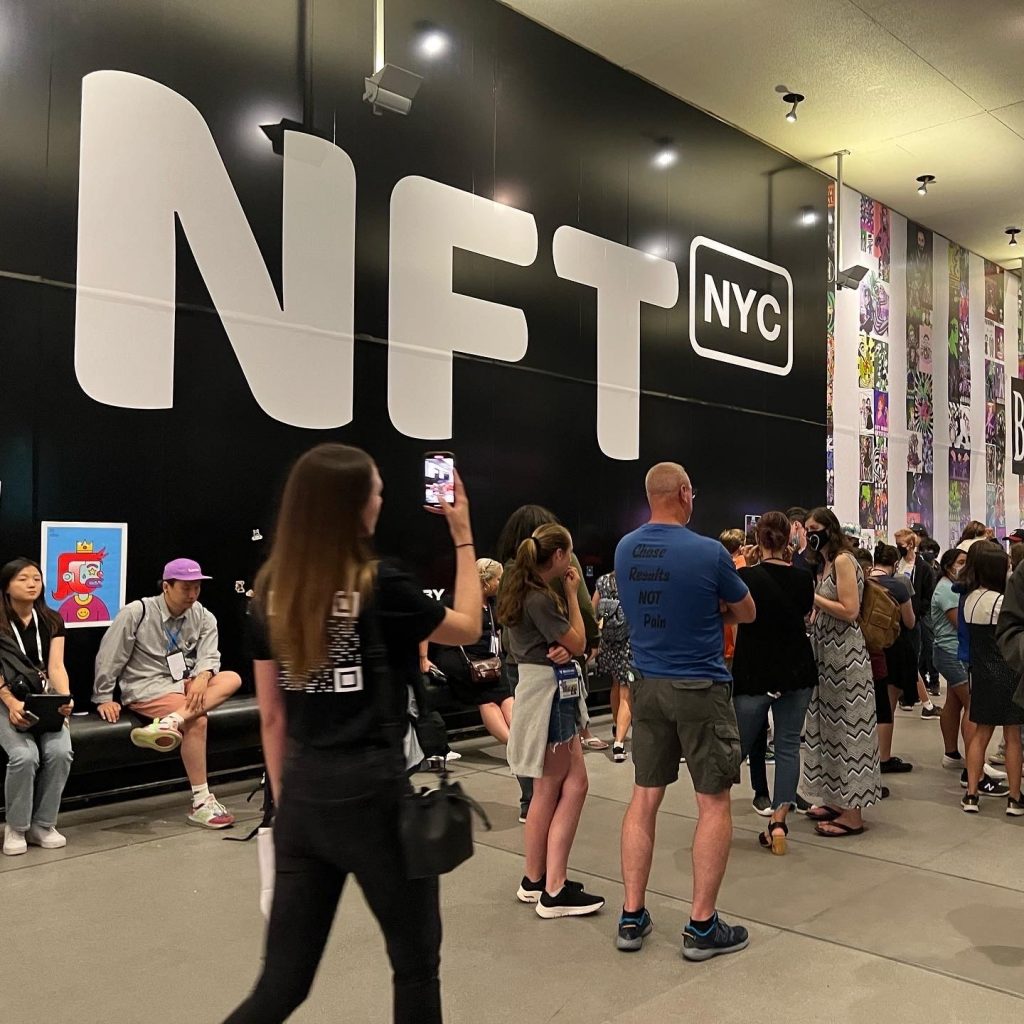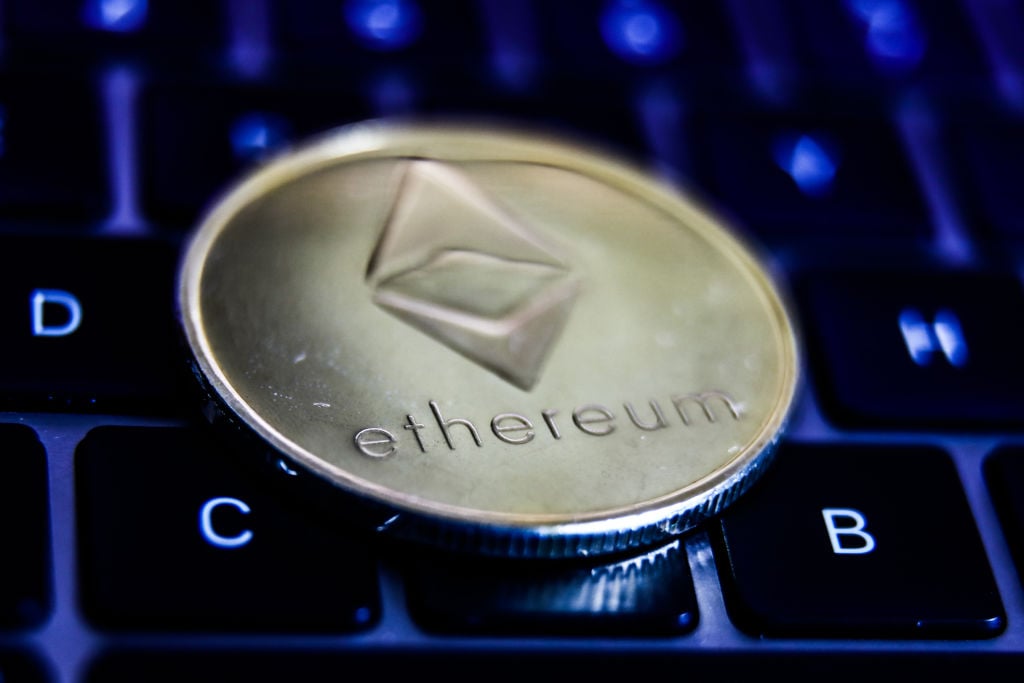Every Wednesday morning, Artnet News brings you The Gray Market. The column decodes important stories from the previous week—and offers unparalleled insight into the inner workings of the art industry in the process.
This week, surveying the roadmap to the crypto art future…
MERGE AHEAD
If you’ve done your best to learn only what you absolutely need to know about NFTs and crypto, I regret to inform you that it’s time to update your priors in a big way. Within roughly the next six weeks, Ethereum, the busiest blockchain in existence, will make a long-fabled switch to its technological DNA. “The Merge” (as Ethereum cofounder Vitalik Buterin dubbed the upcoming move) represents the next milestone on a years-long roadmap aimed at optimizing Ethereum’s usefulness across applications and economic sectors. Yet even its signs of progress cast a few shadows over the NFT and crypto landscape ahead.
To ground this abstract discussion as firmly as possible in approachable terms, let’s go self-Q-and-A style, shall we?

The Ethereum logo against a backdrop of cold hard fiat currency. (Photo Illustration by Budrul Chukrut/SOPA Images/LightRocket via Getty Images)
What is the Merge?
Let’s start from first principles. A blockchain, as you may remember, is effectively a shared database maintained by a network of individual computers owned by different people in different places. (The jargon for these computers and their owners are “nodes” and “node operators,” respectively.) For the database to continue, all the computers must use a mutual system to validate new entries as true and correct before they are added to the historical entries. This mutual system is known as a consensus mechanism.
The two most well-known blockchains, Ethereum and Bitcoin, have both operated from the outset via a consensus mechanism called proof-of-work (PoW). Proof-of-work demands that new “blocks” of database entries can only be added to the historical “chain” of entries after one of the computers in the network solves a complex alphanumeric puzzle (aka a cryptographic hash).
Once the puzzle is solved, the computer that provided the answer is awarded money in the form of a specific cryptocurrency. (The metaphor of digging up a valuable answer compelled crypto heads to name this process “mining.”) Then the winning computer’s comrades in the network update their copy of the database to reflect the addition of the new entries, allegedly keeping the database permanent and immutable.
But in Buterin’s 2014 white paper introducing Ethereum, he signaled that it was “likely” the blockchain would eventually trade proof-of-work for an alternative consensus mechanism known as proof-of-stake (PoS). The Merge, expected to happen sometime next month, is the term of art for Ethereum’s long-awaited switch from PoW to PoS.
Why are we calling this very technical thing “the Merge”?
The name stems from the specific way the core developers of Ethereum have gone about enabling the changeover: basically, by copying every transaction on the currently-operating proof-of-work blockchain (known as Ethereum Mainnet) onto a new proof-of-stake blockchain (known as the Beacon Chain) that has been quarantined from everyone but the developers since its December 2020 launch. This way, the Beacon Chain’s infrastructure could be rigorously built out and tested for as long as necessary without disrupting new Ethereum transactions. The Merge will be the point at which Ethereum Mainnet seamlessly (we hope) connects to the Beacon Chain so the Beacon Chain (and its PoS mechanism) can take over all further updates.

Ethereum cofounder Vitalik Buterin speaking at the ETHDenver conference in February 2022. (Photo by Michael Ciaglo/Getty Images)
How does proof-of-stake work?
Essentially, as a cryptocurrency-powered lottery. Instead of trying to validate new entries by competitively mining the solution to a cryptographic puzzle, collaborators in a proof-of-stake blockchain ante up cryptocurrency as collateral for the opportunity to validate new entries. To extend my analogy, the more cryptocurrency someone “stakes,” the more lottery tickets they get back in return, and the higher their probability of winning more ETH for their service.
For detail hounds, here’s how Timothy B. Lee of Ars Technica explained it:
Every 12 seconds, a pseudorandom number generator selects a subset of stakers to form a committee to decide on the next block. One of them is designated to propose the next block, while the rest, called validators, verify that the new block follows all the rules of the Ethereum network. For example, if the block contains a payment transaction, the validators check that the source address has the required funds, that the transaction has the correct digital signatures, and so forth. If two-thirds of validators approve a block, it becomes part of the official blockchain.
Validators that faithfully follow these rules earn additional ether as a reward for their efforts, with the size of their reward proportional to the ether they’ve staked. On the other hand, if a validator tries to cheat—for example, by validating two different, incompatible blocks for the same blockchain “slot”—they will face financial penalties. If another validator posts evidence of such a cheating attempt, some of the cheater’s collateral will be destroyed (“slashed,” in Ethereum jargon), and the whistleblower will get a reward.
Why is switching to proof-of-stake a big deal for Ethereum and crypto art?
The PoS mechanism will shrink Ethereum’s energy consumption by a staggering amount. Blockchain specialists I trust estimate the reduction will be in the neighborhood of at least 95 percent, which should be a big enough hug to the climate to moot one of the chief ethical arguments against minting and trading NFTs on Ethereum.
“From my POV, it makes Ethereum a viable option for the future of decentralized anything, and I’ll be curious to see if many people who left Ethereum for greener options like Tezos, Algorand, and Solana will migrate back to the mature marketscape, or if the value of the communities within the other L1s will outweigh this,” artist and Web3 developer Addie Wagenknecht said. (L1s are “layer-one networks,” meaning base-level blockchains like the three greener options she referenced.)
What does a minimum 95 percent reduction look like? Wagenknecht said that, post-Merge, the energy cost of staking on the Ethereum blockchain with a single node will approach the energy cost of running a typical home computer. True, the expenditure rises with each additional computer staking on a given network. But the climate impact of an Ethereum network composed of, say, 10,000 Dell desktops is infinitely friendlier than, in her words, “melting down the entire global power grid like Bitcoin or Ethereum does right now.”

Addie Wagenknecht, installation view of “every day the same again” at bitforms, New York. Courtesy of the artist and bitforms.
Will the Merge disarm the other standard criticisms of transacting on Ethereum?
No. Switching to proof-of-stake won’t eliminate (or even tamp down) gas fees, the congestion-priced payments due every time a user transacts on the Ethereum blockchain. On the other hand, Wagenknecht pointed out that some people argue that this apparent flaw is actually beneficial to the crypto space as a whole, because gas fees have helped compel other crypto heads to build or transact on alt-chains like the ones she mentioned above.
Is the Merge the final destination on the new Ethereum roadmap?
No again! The Merge will be followed by four other major milestones: the Surge, the Verge, the Purge, and the Splurge. (I swear to everything sacred that I am not making this up.)
The third phase, the Surge, will implement a scalability upgrade called “sharding” that will optimize the blockchain’s processing power. Today, Buterin said, Ethereum can handle 15 to 20 transactions per second; after the Surge, he estimates it will be able to process 100,000 per second. “What this means for NFT artists is that to mint/post/sell an NFT, you won’t have long wait times due to congestion on the network like you are used to,” Wagneknecht said.
Still, it’s important to pause here and emphasize that the Merge is the only checkpoint on the roadmap that has been definitively settled and scheduled. Everything beyond it is a moving target subject to change in execution and ETA, if not in concept. The Surge isn’t expected to happen until 2023 at the earliest, so periods of high traffic will still translate to long wait times for artists and collectors even after the Merge. In fact, considering that it took roughly eight years just to reach the Merge, I’d advise everyone to keep their expectations in check for how quickly the network will reach the rest of the roadmap.
The roadmap sounds like a huge boost for Ethereum. Are there any downsides for art?
Well, let’s talk about the Purge, the penultimate destination on the current roadmap. Buterin envisions the Purge as a pruning of the huge (and ever-growing) number of entries validated on the Ethereum blockchain. At a macro level, it’s meant to incentivize more everyday enthusiasts to become nodes of the Ethereum network. It just might belie one of the blockchain’s central value propositions to art in the process.
Even after Ethereum moves to proof-of-stake, anyone who wants to validate new additions to the blockchain will still have to first download and process every single previous entry to keep the database complete. The individual entries are tiny, but they add up to a large and ever-growing totality. This totality will also start scaling up at warp speed after the Surge.
Without a structural change, this dynamic would hand a hefty advantage to a small cohort of large institutional players with the hardware resources to store gargantuan amounts of data—the opposite of the decentralized, populist ethic that has guided Ethereum since its inception.
Why should the art world be wary of the Purge? Everything you just said sounds great!
It depends on execution. As of my writing, one prominent early-stage option acts as a great prism onto why. Since old database entries have no direct bearing on validating new ones, the authors of Ethereum Improvement Proposal-4444 suggest that, after the Purge, participants in the network should only be required to jointly maintain the entries validated in the past calendar year.
If you were in a Clubhouse room in 2021 (or a conference in 2018) about art and blockchain, you know that one of the animating conversations was about the technology’s potential to create a new standard of security and comprehensiveness for provenance. Whether an artwork was physical, digital, or (shudder) phygital, its creation and all subsequent ownership transfers could be registered on the blockchain, whose consensus mechanism and supposed immutability across a large network of computers would all but guarantee the data’s long-term integrity.
“People were obsessed with the idea of immutability and the ability to look back at historical transactions going all the way back to the artist, and to know it’s all validated by the node operators. That’s what was supposed to make it better than a typical certificate of authenticity. I’m not saying that I ever thought it was or is better, but that was the rhetoric,” time-based-media specialist Regina Harsanyi said.
As currently described in EIP-4444, however, the Purge exposes how “ridiculous” to Harsanyi this sentiment was. Instead of a complete, secure, validated record of an artwork’s entire lifecycle on the ledger, Ethereum might only be able to directly vouchsafe for what has happened to it in the past 365 days. Any transactions associated with a smart contract or token earlier than this would no longer even contain a jointly validated record of who purchased it over time.

Ed Fornieles, Menuteer (Ethereum), 2016. Courtesy of Arsenal Contemporary New York.
Whoa, so would provenance data older than a year be gone forever?
Not necessarily. It would be gone from the blockchain under EIP-4444, but it could be maintained elsewhere. The present draft of the proposal suggests that historical data should be “preserved and seeded by independent organizations,” such as the InterPlanetary File System (IPFS), the network that stores many of the actual media assets that NFTs only link to. The authors also suggest this off-chain data’s “availability should be checked frequently” to ensure that it remains complete and trustworthy. But the mechanisms for accomplishing these archival functions are considered “out-of-scope” in the current draft.
Still, offloading custodianship to third parties, no matter how trusted, would remove nearly all the protections used to market blockchain to the art world as an evolutionary step forward in provenance and archival integrity.
Are provenance problems the only risk to art after the Purge?
Nope. As just one example, Harsanyi cites artworks created with off-chain software programmed to respond in some way to transactional history on the Ethereum blockchain; these works could essentially “break” forever in a poorly executed Purge.
Imagine (this is my extremely stupid hypothetical, not Harsanyi’s) an animated GIF of an octopus that grows a new tentacle every time its corresponding NFT is resold on Ethereum. If all transaction records older than a year were pruned, then either the poor octopus’s appendages would keep getting severed every day of its miserable life, or the whole image would just decay into an irretrievably corrupted file.

A crowd outside NFT.NYC on June 21. Photo: Katya Kazakina
But wasn’t the blockchain always supposed to be permanent and immutable? You said it yourself near the top of this piece!
Now you know why I said “allegedly”! In what still strikes me as one of the most astonishing and underreported admissions about crypto I’ve ever encountered, Vlad Zamfir, a researcher for the Ethereum Foundation who doubled as one of its earliest members in the pre-launch days, claimed on the Odd Lots podcast last year that the immutability narrative was only ever “tactical misinformation that happened from the start in order to protect the blockchain from what were seen as political and legal adversaries that are too strong for us.”
In other words, if a blockchain’s infrastructure or entries could be changed just like any other technology product, then governments or other institutions would feel compelled to step in and try to dictate terms. In Zamfir’s telling, pseudonymous Bitcoin founder Satoshi Nakamoto and other early blockchain developers “kind of tried to front run this by saying, ‘It’s immutable, and we decided this is the protocol forever.’ That is kind of bullshit, but that doesn’t mean blockchain is not useful. It’s quite the opposite.”
So, are NFTs, crypto art, and blockchain-based provenance all dead on arrival?
Probably not. Again, the Purge is still years away, and EIP-4444 is just one way it could play out. A disclaimer at the top of the proposal even states that it is “not recommended for general use or implementation as it is likely to change.” Harsanyi is also optimistic that the plan could be revised in a way that protects the archival and programmatic aspects of NFTs and crypto-involved art. (She has some specific ideas that I won’t risk misrepresenting here.)
Still, the Merge, the Purge, and their other rhyming milestones serve as a great reminder about blockchains overall: in Harsanyi’s words, “The software is only as immutable as the consensus allows it to be.” You wouldn’t have to change many words in that sentence to deliver an equally true statement about the art market in general, and that’s worth keeping in mind no matter how you feel about NFTs.
[Ars Technica]
That’s all for this week. ‘Til next time, please: remember the octopus : _ (











